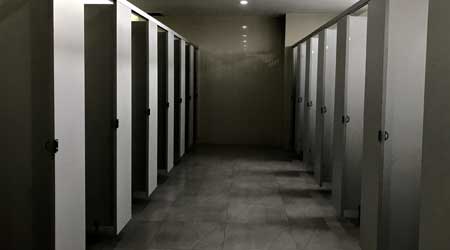
COVID-Proofing the Restroom: Concerns Abound
May 27, 2020
Impeccable cleanliness and design for all in the restroom is table stakes for any Class A facility. It is a critical space which colors the perception of the rest of the facility and impacts user experience on a daily basis. As workers filter back into the office over the next weeks and months, it will be the one space they can likely not avoid if they’re hoping to make it through a full workday.
In the context of COVID-19, concerns around restrooms are likely to impact how quickly and seamlessly we return to the public sphere, according to the Washington Post. Businesses are employing many strategies to try to improve the restroom experience at their establishment. These include increased frequency of cleaning, removing fixtures from use to increase space between them, and employing restroom monitors to ensure proper spacing while queuing.
Removing touchpoints is inspiring some facilities to remove the door to the bathroom all together and changing the entrance to be more like those seen in airports. Other strategies involve foot and elbow pulls, though that does not solve the problem of the entrance for all users.
One situation that facility managers may need to consider is putting a lid on toilets. Nearly unheard of in commercial facilities, the toilet seat helps to block pathogens from the toilet plume that occurs upon flushing. A related consideration might be fine-tuning sensors on flushometers to eliminate the multiple false flushes that can occur.
Movement of air will be more closely scrutinized by restroom users. If odors linger, occupants may wonder what else is lingering in the air. Hand dryers may fall out of favor as patrons reach more for paper towels to dry their hands.
Regardless of what other strategies are employed in the restroom, proper handwashing remains a critical step. Unfortunately, most adults are not the best at it. A Michigan State University study found that 95 percent of people who do wash their hands don’t do it long enough to make a difference, according to Business Insider. With pandemic fatigue likely setting in, putting up signage or coming up with repeated messaging in the restroom about the importance of scrubbing up for 20 seconds will be helpful.
Another strategy could be increasing the number of hand washing stations in the restroom, as well as throughout the space. According to the BBC, washing hands between six and 10 times a day cuts the risk of infection. Portable handwashing stations could be installed in spots such as outside of anywhere touching a door handle will be unavoidable, or in the breakroom. It used to be common design practice to have a handwashing sink in the entrance vestibule to a home. Perhaps as a sign of hospitality and mutual respect, such a handwashing ritual could be adopted in the public sphere as well.
Naomi Millán is senior editor of Building Operating Management.
Next
Read next on FacilitiesNet












